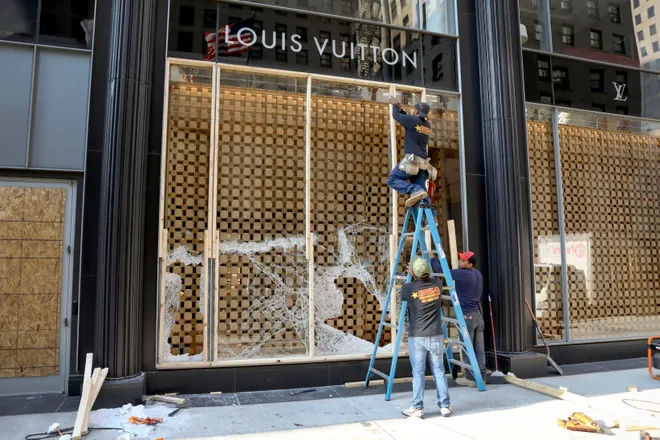Is shoplifting on the rise? Retail data shows it's fallen in many cities post-pandemic
In 2021, upwards of 30 people robbed a Best Buy in Minneapolis on Black Friday, in tandem with another Best Buy store in the metro area.
That same year, retailers reported a 26.5% increase in organized retail crime incidents from 2020, according to the National Retail Federation (NFR) survey. Organized retail crime usually refers to a group of professional shoplifters who perpetrate large scale retail-theft with the intent to resell merchandise. All types and sizes of businesses may fall victim to organized retail crime, according to the U.S. Chamber of Commerce.
The NRF estimated that organized retail crime costs companies an average of 7 cents for every $100 in sales.
With Black Friday around the corner, retailers are aware of the sometimes dangerous and costly risk of shoplifters. So how is shoplifting, a subset of retail theft, impacting retailers this year?
Which cities experienced a rise in shoplifting cases?
The Council on Criminal Justice looks at shoplifting incidents within 24 cities over the past five years. Their report found the following trends:
- New York and Los Angeles had the largest uptick in reported shoplifting incidents among the 24 cities from mid-year 2019 to mid-year 2023.
- St. Petersburg and St. Paul had the largest decreases in shoplifting incidents during that same time period.
Shoplifting rates since pre-pandemic
- During the height of the pandemic (January 2020 to June 2020), there was a 37% drop in reported shoplifting incidents.
- Reported shoplifting rates increased from July 2020 to December 2020 as businesses reopened, but those shoplifting rates remained far below pre-pandemic levels in 2018 and 2019..
Shoplifting as a felony increases
- Data suggests that the value of shoplifting incidents has increased since 2019. The share of shoplifting incidents categorized as felonies increased from 6.6% in January of 2019 to 15.1% in January of 2023.
How are retailers responding to shoplifting?
Major grocers drugstores, and other retail outlets have cited shoplifting as their reason for closing multiple locations and placing goods behind counters and in locked cases, according to the report. But some industry researchers say retailers are blaming profit losses on shoplifting incidents when the actual cause is internal flaws, such as overstocked inventories.
Safeway cited theft when it cut back the hours of a San Francisco store in 2021, and Walmart CEO Doug McMillon said last December that a spike in shoplifting could lead to store closures.
Some companies are turning to more advanced technology, like self-servicing locking cabinets or smart shopping carts. Walgreens in June announced that it is testing a new store concept in Chicago that has most merchandise under lock and key.
Customers pay the price:How stores are curbing shoplifting incidents
'Modern-day-mafia':14 charged in Florida retail theft ring that stole $20 million in goods

Limited data draws unclear conclusions about retail theft
Because shoplifting data is self-reported, the authors of the report say the true number of shoplifting incidents is almost certainly higher. Limited data does not allow for the authors to examine different factors that may be influencing shoplifting trends.
Charis Kubrin, a criminology professor at the University of California, Irvine told USA TODAY that the gap in available data makes it difficult to analyze crime trends. She believes that while there are likely certain neighborhoods and cities where theft has risen, others may have seen levels fall.
“The key is identifying at a more local level where this is happening,” she said. “I think claiming that retail theft is out of control, or you know, headlines that are particularly alarmist, I think are really off base because we simply don't know at this point.”
How was the data collected?
The shoplifting data collected by the Council on Criminal Justice comes from 24 individual cities that have consistently reported their shoplifting incidents over the past five years, as well as the U.S. Justice Department’s National Incident-Based Reporting Program. The NIBRS data include a sample of 3,812 local law enforcement agencies.
Bailey Schulz contributed to this reporting
Disclaimer: The copyright of this article belongs to the original author. Reposting this article is solely for the purpose of information dissemination and does not constitute any investment advice. If there is any infringement, please contact us immediately. We will make corrections or deletions as necessary. Thank you.






